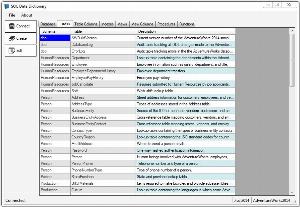

The difference is, the keyword ‘IS’ is used when the procedure is nested into some other blocks and if the procedure is standalone then ‘AS’ is used. IS | AS Clause, they set the context to execute the stored procedure.


option allows the modification of an existing procedure.procedure-name specifies the name of the procedure.IN OUT: This parameter is used for both giving input and for getting output from the subprograms.OUT: It is used for getting output from the subprograms.It is a read-only variable inside the subprograms and its value cannot be changed inside the subprogram. IN: T his is the Default Parameter, which always receives the values from the calling program.There are 3 different types of parameters, which are as follows: In other words, parameters are used to pass values to the procedure. SQL statement used in the stored procedureĪ parameter is a variable that holds a value of any valid SQL datatype through which the subprogram can exchange the values with the main code. The following illustrates the basic syntax of creating a procedure in SQL:ĬREATE PROCEDURE procedure_name [ Now that you know what procedures are and why they are needed, let’s discuss the syntax and example of procedure in SQL. Return a status value to a calling procedure or batch to indicate success or failure and the reason for failure.Supports a simple, but powerful condition and error-handling model.SQL procedures promote reusability and maintainability.More reliable than equivalent external procedures.Supports three types of parameters, namely, input, output, and input-output parameters.Easy to implement because they use a very simple high-level, strongly-typed language.Listed below are key features of the SQL procedures: A SQL procedure is a group of SQL statements and logic, compiled and stored together to perform a specific task. In this article, let’s explore procedures in SQL with syntax and examples.Ī procedure in SQL (often referred to as stored procedure), is a reusable unit that encapsulates the specific business logic of the application. Just as you can in other languages, you can create and drop procedures in SQL as well. Grant the minimum database access that is necessary for the application.Ĭode org/zaproxy/zap/extension/ascanrules/SqlInjectionSqLiteScanRule.Procedures are the subprograms which can be created and saved in the database as database objects. This does not eliminate SQL injection, but minimizes its impact. In particular, avoid using the 'sa' or 'db-owner' database users. Apply the principle of least privilege by using the least privileged database user possible. Apply an 'allow list' of allowed characters, or a 'deny list' of disallowed characters in user input. Escape all data received from the client. Do *not* concatenate strings into queries in the stored procedure, or use 'exec', 'exec immediate', or equivalent functionality! Do not create dynamic SQL queries using simple string concatenation. If database Stored Procedures can be used, use them. If the application uses JDBC, use PreparedStatement or CallableStatement, with parameters passed by '?' If the application uses ASP, use ADO Command Objects with strong type checking and parameterized queries. In general, type check all data on the server side. Do not trust client side input, even if there is client side validation in place.


 0 kommentar(er)
0 kommentar(er)
